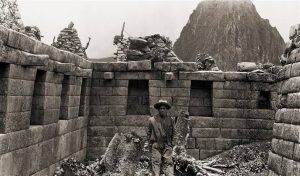On a day like today, in 1911, the archaeologist and history professor at Yale University, Hiram Bingham, found the Inca citadel of Machu Picchu. The expedition was with the idea of discovering the Inca city of Vilcabamba. Dr. Giesecke, rector of the University of San Antonio Abad in Cusco, announced that Inca ruins existed in Mandor.
With the help of a farmer and children, on July 24 (despite the terrible weather conditions), Bingham arrived at the ruins of Machu Picchu.
Several specialists believe that other characters visited the place, such as Augusto Berns. Charles Wiener traveled the Andes between the years 1875 and 1877. In his book Peru and Bolivia, he made reference to a place called Machu Picchu. However, the reason why he did not explore the site is unknown.
Hiram Bingham and his travels

The first was the one already mentioned (1911). Here he captured several photographs, especially one of the Temple of the 3 Windows, El Torreón. For his second trip, he was funded by Yale University and The National Geographic Society in 1912 before a happy discovery. In all his expeditions, photographs of such an ancient relic were not lacking. He took around 11,000 photos.
In his book The Discovery of Machu Picchu he wrote «Suddenly I found myself standing in front of the walls of a ruin and houses built with the best quality of Inca art. […] I found brilliant temples, royal houses, and a large plaza. be in a dream. «
In the 20s the excavations and the consolidation of Machu Picchu began. This action persisted until the 1950s, and that is when the complex was opened for tourist activity.
Since July 7, 2007, Machu Picchu belongs to one of the wonders of the world. Its history and architecture continue to amaze thousands of tourists.
9 years before
The Cuzco-born Américo Rivas is the author of the work, entitled «Agustín Lizárraga: the great discoverer of Machu Picchu», and where he adds abundant unpublished details to a story already known and accepted by specialists, but still unknown to the general public even in Peru itself.
Rivas has long sought justice before, although, in part, this matter has become personal. However, he has dedicated years of research, with which he has been filling the gaps of a story that, being a native of Santa Teresa (a town located seven kilometers from Machu Picchu), he had heard since he was a child.
«Every Sunday I went to have lunch at the citadel and there I listened to the story from my grandparents. Also, a Lizárraga family lived near my house who also told the same version», he recalled during an interview with Efe.
Nine years before the arrival in Machu Picchu of the American Hiran Bingham, the Peruvian farmer Agustín Lizárraga came to the Inca citadel, a little-known story that now some Cuzqueños seek to vindicate with the publication of the first book on the subject.
Despite not having the resources that Bingham had, Lizarraga went down in history without any kind of recognition. «Lizárraga had no newspaper, no magazine, and Hiram Bingham had US President William Howard Taff, the President of Peru, Augusto B. Leguía, National Geographic, Yale University, and his millionaire friends», argued Rivas.
Pandemic
The Sanctuary is currently closed due to the Covid-19 pandemic. It is under evaluation that the Cusco region, where this Sanctuary is located, returns to quarantine. It should be remembered that its reopening was scheduled for today.
However, the number of infections in the region, as well as in the entire country, has risen dramatically.